| Anglerfishes |
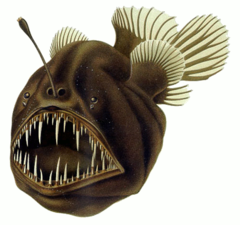
Melanocetidae: humpback anglerfish, Melanocetus
johnsonii
|
|
Scientific classification |
|
|
| Suborders |
Antennarioidei
Lophioidei
Ogcocephalioidei
See text for families. |
Anglerfishes are bony fishes in the
order Lophiiformes.[1]
An anglerfish has a head of enormous size, broad, flat
and depressed, with the remainder of the body appearing
merely like an appendage. Anglerfish may grow to a length of
200 cm (6.5 feet); specimens of 90 cm (3 ft.) are common.
It's maximum weight is 30 kilos (1000 US ounces)
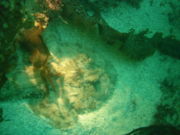
Monkfish in natural envorinment
Anglerfishes are, for the most part, deep-sea fishes,
though there are some families that have shallow-water
representatives, including one, the frogfishes (family
Antennariidae), that occurs only in shallow water. Examples
of other anglerfish families that have some shallow water
species are the goosefishes (family Lophiidae) and the
batfishes (family Ogcocephalidae). These families also have
deep water representatives. The deep-sea mid-water
anglerfishes belong to the superfamily Ceratioidea.
The order was formerly known as Pediculati.
Predation
Anglerfishes are named for their characteristic method of
predation, Angler being another word for fisherman. The anglerfish
has three long filaments sprouting from the middle of its
head; these are the detached and modified three first spines
of the anterior dorsal fin. As with all anglerfish species,
the longest filament is the first (the illicium). This first
spine protudes above the fish's eyes, and terminates in an
irregular growth of flesh (the esca) at the tip of the
spine. The spine is movable in all directions, and the esca
can be wiggled so as to resemble a prey animal, and thus to
act as bait to lure other predators close enough for the
anglerfish to devour them whole. The jaws are triggered in
automatic reflex by contact with the tentacle. (The netdevil
anglerfish has similar growths protruding from its chin as
well.)
As most anglerfish live mainly in the oceans' aphotic
zones, where the water is too deep for sunlight to
penetrate, their predation relies on the "lure" being
bioluminescent (via bacterial symbiosis). In a related adaptation, anglerfish are dull
gray, dark brown or black, and are thus not visible either
in their own light or in that of similarly luminescent prey.[2]
The wide mouth extends all around the anterior
circumference of the head, and both jaws are armed with
bands of long pointed teeth, which are inclined inwards, and
can be depressed so as to offer no impediment to an object
gliding towards the stomach, but to prevent its escape from
the mouth. The anglerfish is able to distend both its jaw
and its stomach (its bones are thin and flexible) to
enormous size, allowing it to swallow prey up to twice as
large as its entire body.
Some benthic (bottom-dwelling) forms have arm-like
pectoral fins which the fish use to walk along the ocean
floor. The pectoral and ventral fins are so articulated as
to perform the functions of feet, the fish being enabled to
move, or rather to walk, on the bottom of the sea, where it
generally hides itself in the sand or amongst sea-weed. All
around its head and also along the body the skin bears
fringed appendages resembling short fronds of sea-weed, a
structure which, combined with the extraordinary faculty of
assimilating the colour of the body to its surroundings,
assists this fish greatly in concealing itself in places
which it selects on account of the abundance of prey.
Reproduction
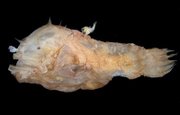
Linophrynidae: A 46 mm female Photocorynus
spiniceps with male
attached to its back. The adult males of this
species, less than 1 cm long, are among the
smallest adult vertebrates.
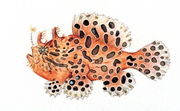
Antennariidae: striated frogfish, Antennarius striatus
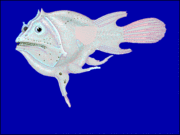
Linophrynidae: Haplophryne mollis

Chaunacidae: pink frogmouth, Chaunax pictus: B.K.
Phillips

Ceratiidae: Krřyer's deep sea angler fish, Ceratias
holboelli
Some anglerfish have a unique mating method. Since
individuals are rare and encounters doubly so, finding a
mate is a problem, especially at a time when both
individuals are ready to spawn. When scientists first
started capturing ceratioid anglerfish, they noticed that
all of the specimens were females. These individuals were a
few inches in size and almost all of them had what appeared
to be
parasites attached to them. It turned out that these
"parasites" were the remains of male ceratioids.
When a male of one of these species hatches, it is
equipped with extremely well developed
olfactory organs that detect scents in the water. They have
no digestive system, and thus are unable to feed
independently. They must find a female anglerfish, and
quickly, or else they will die. The sensitive olfactory
organs help him to detect the pheromones that signal the
proximity of a female anglerfish. When he finds a female, he
bites into her flank, and releases an enzyme which digests
the skin of his mouth and her body, fusing the pair down to
the blood vessel level. The male then atrophies into nothing
more than a pair of gonads that release sperm in response to
hormones in the female's bloodstream indicating egg release.
This is an extreme example of sexual dimorphism. However, it ensures that when the
female is ready to spawn, she has a mate immediately
available.[2]
The spawn of the angler is very remarkable. It consists
of a thin sheet of transparent gelatinous material 2 or 3
ft. broad and 25 to 30 ft. in length. The eggs in this sheet
are in a single layer, each in its own little cavity. The
spawn is free in the sea. The larvae are free-swimming and
have the pelvic fins elongated into filaments.
Consumption
In Europe, the tail meat is widely used in cooking and is
often compared to lobster tail in taste and texture. It is
therefore sometimes referred to as "poor man's lobster." The
anglerfish is a culinary speciality in certain Asian
countries. In Japan each fish sells for as much as USD$150.
The liver alone, considered a great delicacy, can cost
USD$100.
References
-
^
"Lophiiformes".
FishBase. Ed. Ranier Froese and Daniel Pauly.
February 2006 version. N.p.: FishBase, 2006.
- ^
a b
Ramsey Doran.
Deep sea anglerfish. Retrieved on 3 April 2006.
This article incorporates text from the
Encyclopćdia Britannica Eleventh Edition, a
publication now in the
public domain.




